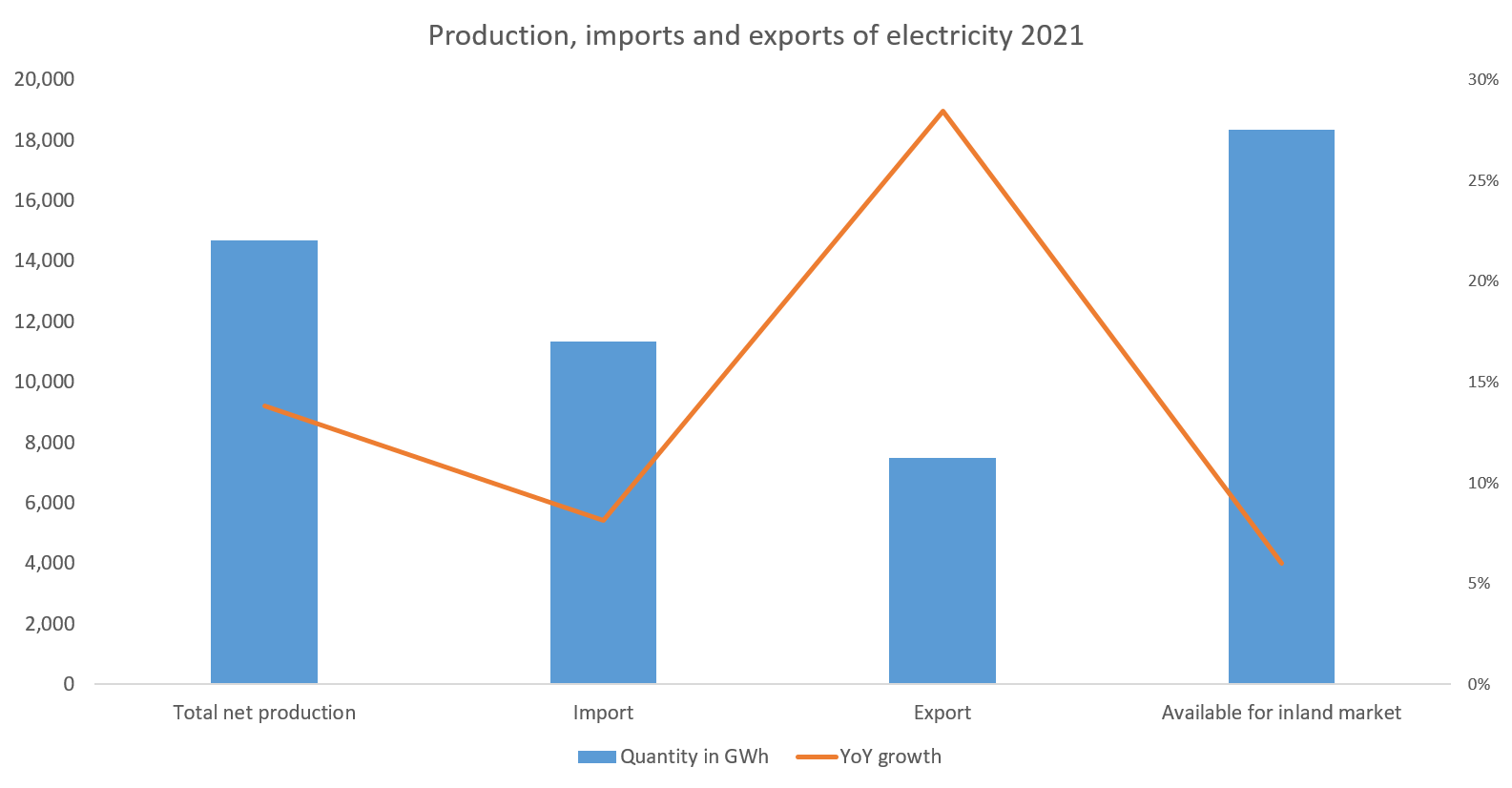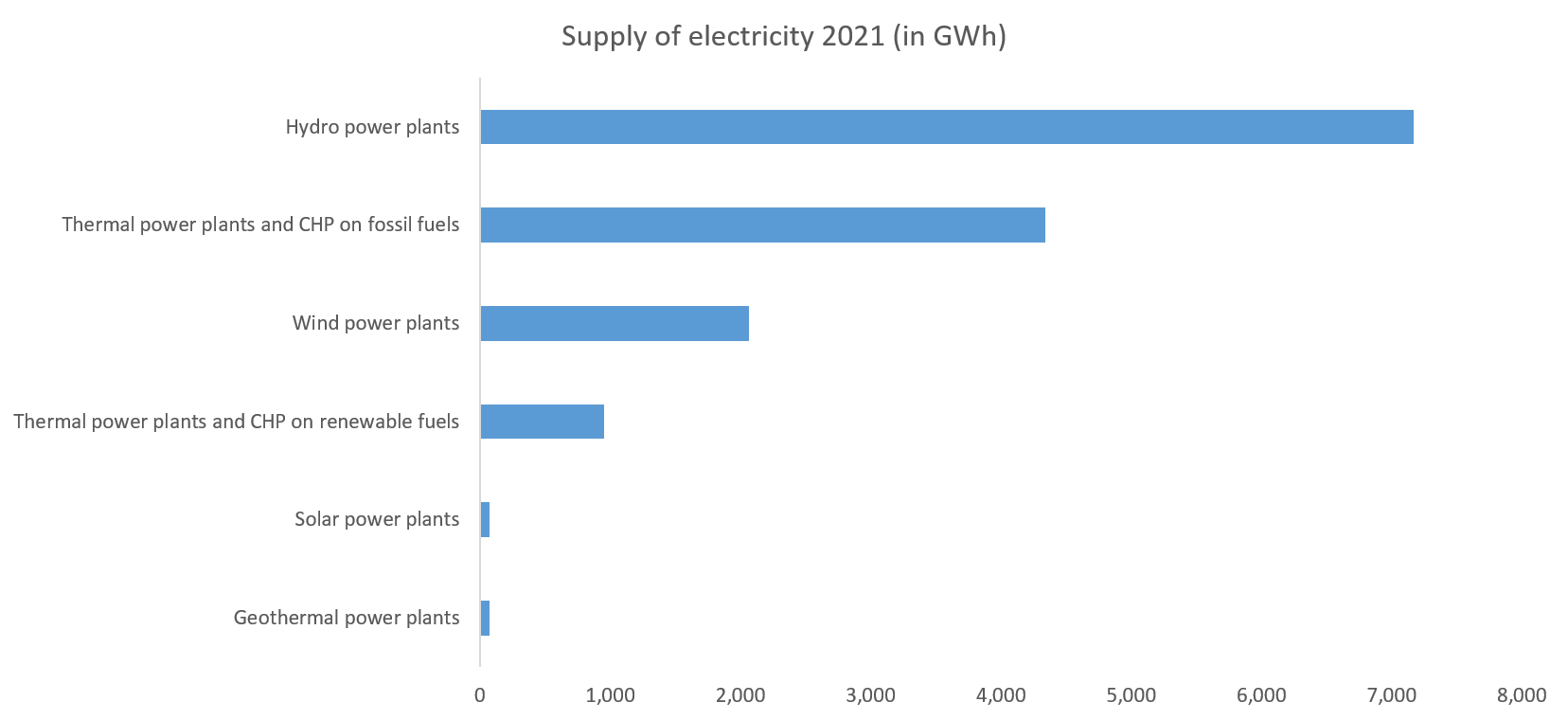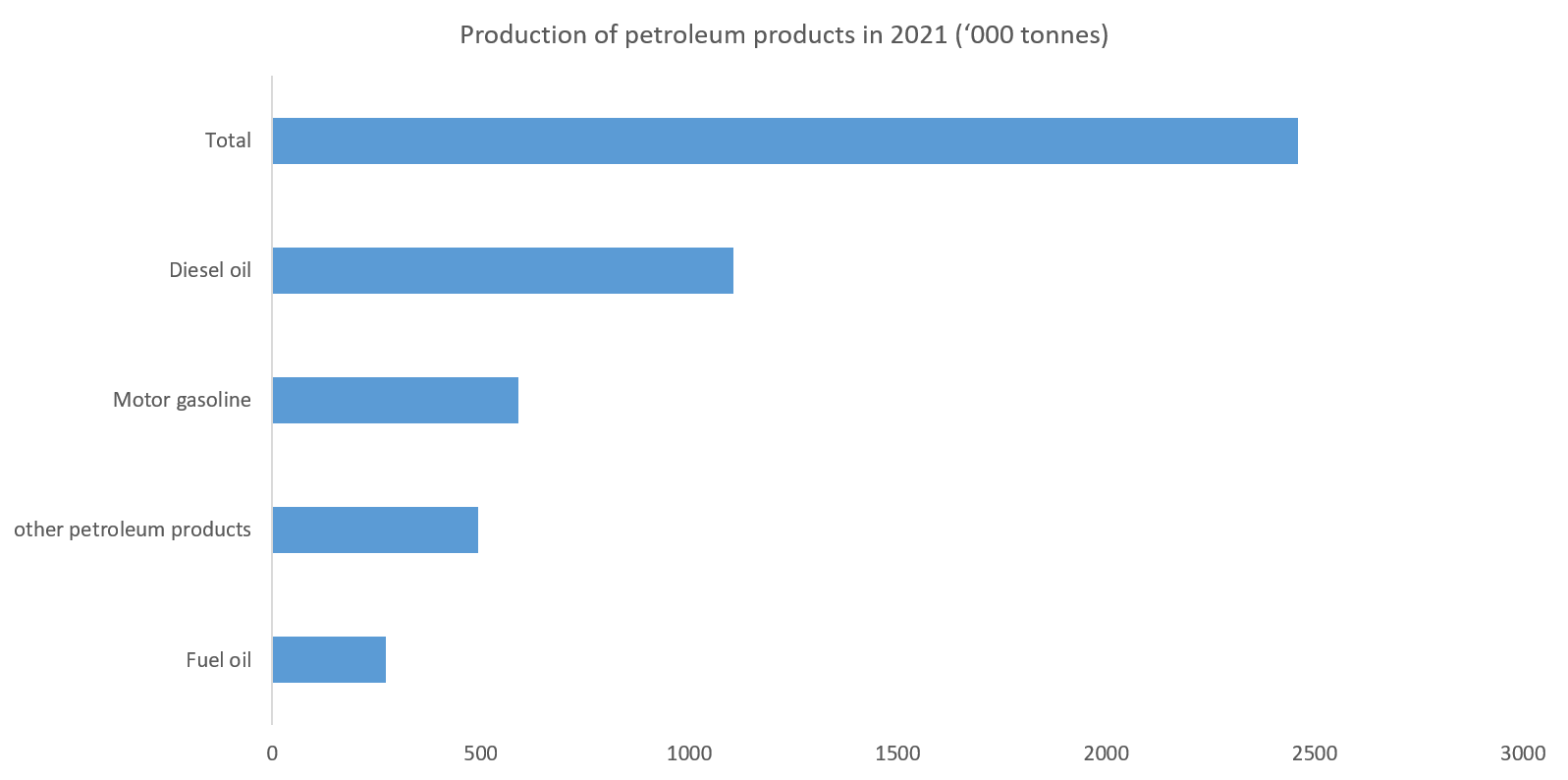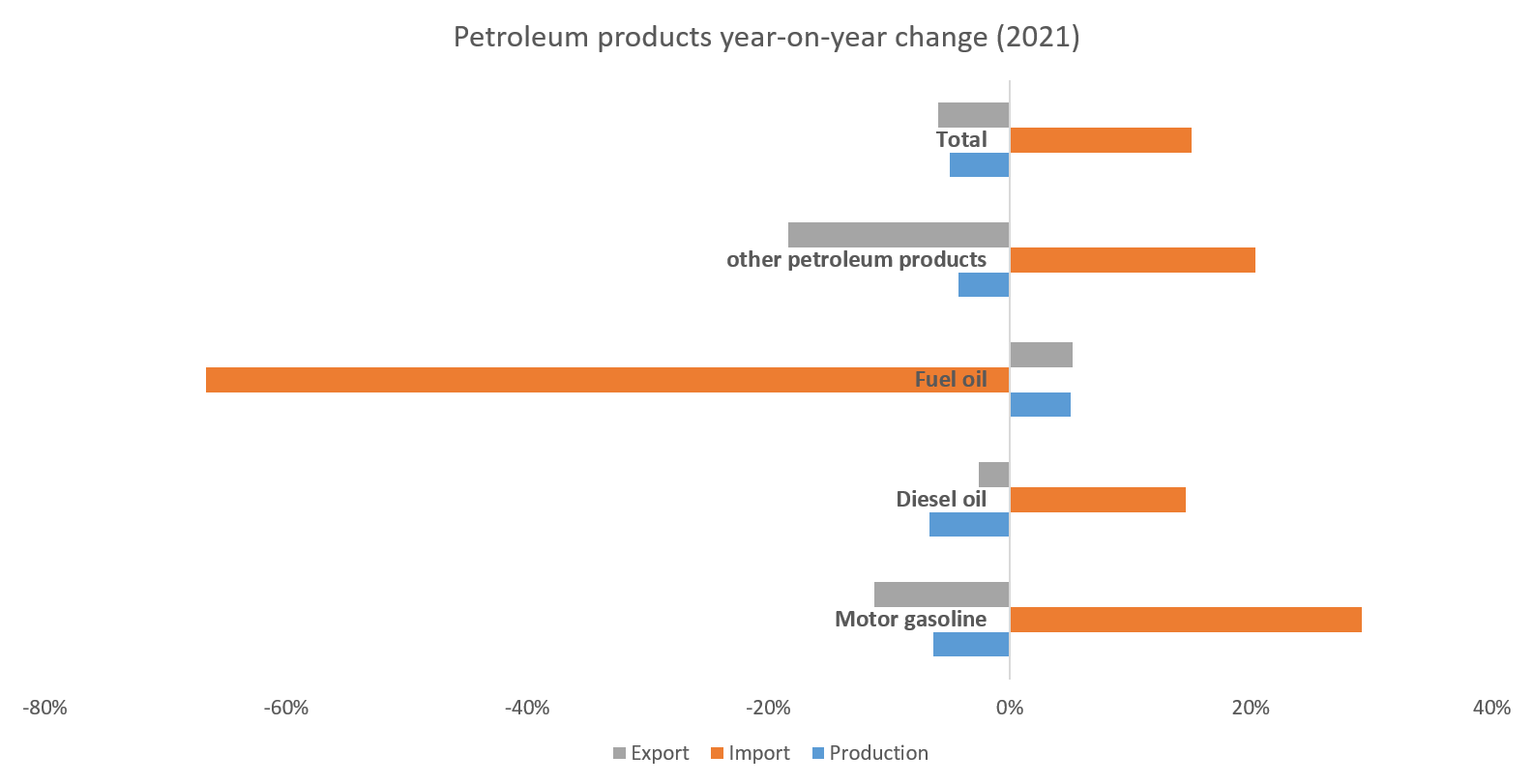Croatian Energy Sector 2021: An Overview
March 7th, 2022 - An overview of the Croatian Energy Sector 2021.
The energy sector is a hot topic these days, and it is not a coincidence since rising prices of electricity, natural gas, and crude oil determine the prices in the overall economy. Energy prices determine the production costs, transportation costs, electricity costs, heating costs among many others. There is a rising concern over the ecological impact of the energy sector as well as the geopolitical impact that has never been more relevant.
Taking into consideration the aforementioned effects, I will shortly go through the energy statistics for 2021 reported by DZS which will give a short description of the Croatian energy sector as it was in 2021.
ELECTRICITY
In 2021, Croatia had total net production of electricity at 14 686 GWh, which is an increase of 14% compared to 2020. Exports and imports amounted to 7505 and 11 342 GWh which leads to 18 359 GWh of electricity available for the inland market. Exports recorded the highest growth with a 28% increase compared to 2020. It should be noted that the imports also include electricity produced by the nuclear power plant Krško in Slovenia of which HEP (Croatian state-owned electricity group) holds 50%.

In 2021, 48.8% of the electricity produced in Croatia came from hydropower, 29.6% from thermal power plants and CHP on fossil fuels, 14% from wind power, and 6.5% from thermal power plants and CHP on renewable fuels. Solar power plants and geothermal power plants accounted for only 1%. Around 70% of Croatia's total net production comes from renewable resources.

NATURAL GAS
In 2021, production of natural gas in Croatia amounted to 780 mln m3, which is a decrease of 12% compared to 2020. Imports amounted to 2240 mln m3 with an increase of 4%, while exports reached 76 mln m3. From natural gas that is available for the inland market, 76.5% comes from imports. Croatia is clearly a natural gas net importer with an export-to-import ratio of 0.03.
CRUDE OIL
In 2021, the production of crude oil in Croatia reached 558 thousand tonnes, a decrease of 4.6% compared to 2020. Imports were at 1767 and exports at 490 thousand tonnes. Both imports and exports were experiencing a year-on-year decrease with 9.2% and 22.5% each, respectively. Refinery input in 2021 was 1849 thousand tonnes which were also lower by 5.8%. Again, as with natural gas, Croatia is a crude oil net importer with an export-to-import ratio of 0.27.
PETROLEUM PRODUCTS
In 2021, 2461 thousand tonnes of petroleum products were produced in Croatia which is a decrease of 4.9% compared to 2020. Gas/Diesel oil had the biggest share with 45%, followed by motor gasoline with 24%.

All observed categories of petroleum products experienced a decrease in the level of production, except for fuel oil which saw an increase of 5%. The same holds for imports and exports, all of the categories except fuel oil saw an increase in imports and decrease in exports compared to 2020.

Looking at the export-import ratio we can see that Croatia is a net exporter in both motor gasoline and fuel oil with ratios of 1.875 and 21.91 in that order. On the other hand, Croatia is a net importer of Gas/Diesel oil and other petroleum products with ratios of 0.49 and 0.59. The category of petroleum products as a whole also has higher imports than exports with a ratio of 0.73.
CRUDE FUELS
Crude fuels are made of hard coal, coke, and brown coal. Croatia does not produce either of these three subcategories of crude fuels. In 2021 Croatia has imported 669 thousand tonnes of hard coal, 29 thousand tonnes of coke, and 4 thousand tonnes of brown coal. Comparing the import data with 2020, we can observe an increase of both hard coal and coke imports by 13.4% and 3.6% respectively. On the contrary brown coal, imports have decreased by 77.8%.
For more, check out our business section.
Location for Radioactive Waste Management Centre Taken Over by Fund
ZAGREB, April 1, 2020 - The fund for financing the decommissioning of Krško Nuclear Power Plant and the disposal of its radioactive waste stated on Tuesday that it had received the approval from the Energy and Environment Ministry for the use of former Čerkezovac barracks for establishment of a Radioactive Waste Disposal Centre.
The former Čerkezovac barracks are at Trgovska Gora in the municipality of Dvor on the left bank of the River Una.
The Zagreb-based Fund says in its press release that during the implementation of the project it would permanently cooperate with the local community and the general public as well as with stakeholders across the border, that is nearby municipalities in Bosnia and Herzegovina.
Bosnia and Herzegovina municipalities that are located on the border with Croatia and gravitate towards the River Una fear that radioactive waste from Trgovska Gora would pollute the environment on both sides of the border and harm the health of local residents.
Establishing the centre, Croatia will manage the radioactive waste in a safe, systematic and tested way, said the fund.
The Krško nuclear power plant is jointly owned by Croatia and Slovenia and is located in the Slovenian town of Krško.
Croatia's national programme for the implementation of a strategy for the management of radioactive waste has been submitted to the European Atomic Energy Community (EURATOM), which is expected to evaluate it, and Bosnia and Herzegovina is seeking guarantees that the programme will not have a negative impact on the country.
More energy news can be found in the Business section.
Szijjarto Reiterates Hungary's Interest in LNG Terminal Project
ZAGREB, March 5, 2020 - Hungarian Minister of Foreign Affairs and Trade Peter Szijjarto said on Thursday that Hungary wanted to participate in the LNG terminal project on the northern Adriatic island of Krk, expressing hope that Croatian Environment and Energy Minister Tomislav Ćorić would soon convene a working group on Croatia's part.
Asked by reporters if there had been any progress with regard to Hungary's participation in the LNG terminal project, Szijjarto said that Hungary considered its energy cooperation with Croatia as "a game changer in the region." He said that there had been a lot of talk about diversification of energy supply routes but that nothing had really happened in that regard in the entire region.
Hungary sees the LNG terminal on Krk island as a huge opportunity for Hungary, for Croatia and for the entire region, Szijjarto said after signing a statement of intent with Croatian Minister of the Sea, Transport and Infrastructure Oleg Butković to boost economic cooperation and transport ties between the two countries' border areas.
He said that Hungary had put forward a three-point proposal to Croatia.
First, to connect and combine the gas delivery networks of the two countries, which would eliminate the border crossing fees and make gas supply cheaper for both countries.
Second, to start together negotiations with external partners on gas deliveries to the terminal, primarily with Egypt, Qatar, Australia and the United States.
And third, Hungary is ready to buy a stake in the LNG terminal and Croatia should say what would be an acceptable size, because the terminal is Croatian.
"This is a comprehensive proposal from our side, for which we have a working group. I hope that Minister Ćorić will be ready to convene a working group on the Croatian side as well, as soon as possible," Szijjarto said.
Emphasising the importance of this project, he said that it has "a game-changing significance from our perspective because currently, when it comes to diversification of sources, this is the only viable solution for the upcoming years."
The value of the floating LNG terminal is estimated at €234 million. The European Commission has granted €101.4 million for the construction of the LNG terminal given that the project is included on the European Commission's list of projects of common interest.
Hungary made an offer to buy a 25% stake in the LNG terminal in 2018.
The Croatian government decided in early 2018 to allocate €100 million for the project, notably €50 million in 2019 and €50 million in 2020. The remaining €32.6 million would be provided by the founders of the LNG Croatia company - the electricity provider HEP and the natural gas supplier Plinacro.
More energy news can be found in the Business section.
Construction of Omišalj-Zlobin Gas Pipeline Going as Planned
ZAGREB, March 3, 2020 - The construction of a gas pipeline for the LNG terminal along the Omišalj-Zlobin route is going according to plan and the completion of that HRK 430 million investment is planned for the end of this year, the Plinacro natural gas transmission company reported on Tuesday.
The construction works, which began in mid-December, are being conducted along the entire gas pipeline route from the future Zlobin hub to the future intersection in Omišalj, Plinacro said in a press release.
Preparations have been conducted along the entire route with 60% of the required trenches already dug out and some sections of the pipeline already put in place in the trenches. Welding has also commenced and work at the intersection sites are underway.
Intensive activities are being conducted on Krk island so that that part of the construction can be completed before the tourism season.
The works should be completed and be ready once the LNG terminal becomes operational to start shipping gas from the terminal along the pipeline.
After the completion of the construction of the first compressor station on Croatia's gas transmission system in Velika Ludina, this is the second largest project of Plinacro's third investment cycle launched in 2018.
The project was supported by the European Commission and received a grant of a little more than €16 million for the costs of construction.
More energy news can be found in the Business section.
EBRD and USAID Assist in Connecting Croatia and Bosnia Gas Pipelines
ZAGREB, February 19, 2020 - Representatives of the BH-gas company, the European Bank for Reconstruction and Development (EBRD) and the US Agency for International Development (USAID) on Wednesday signed a grant agreement in Sarajevo for a project to connect Bosnia and Herzegovina's and Croatia's gas networks.
BH-gas, which is the largest gas provider and distributor in Bosnia and Herzegovina, said in a press release that the agreement would activate funds earmarked for environmental impact and feasibility studies for the South Gas Interconnection project.
The project involved building a gas pipeline from Zagvozd in southern Croatia toward Posušje and on to Travnik in Bosnia and Herzegovina, with a special pipeline branching off to Mostar.
The project would secure an additional gas supply route for Bosnia and Herzegovina which has been entirely dependent on Russian gas for decades via a trunk pipeline through Serbia.
The project was launched because the Republika Srpska entity authorities refuse to agree to connecting the two countries' gas networks along the shortest and cheapest route, running from Slavonski Brod to Bosanski Brod.
Northern areas of Bosnia and Herzegovina located in the Serb entity still do not have access to gas as an energy product and the authorities in Banja Luka want to build a new pipeline that would pass exclusively across the entity's territory and be connected to Serbia's gas network.
USAID is providing $500,000 for the South Gas Interconnection project while the remaining costs will be covered by the EU.
BH-gas expects the project documentation to be completed by the end of the year.
More energy news can be found in the Business section.
Croatian Association for Hydrogen Energy Organises Hydrogen Week
ZAGREB, February 17, 2020 - The recently founded Croatian Association for Hydrogen Energy is organising Hydrogen Week, which will take place as part of an informal meeting of the EU environment and energy council from 26 to 28 April in Split and on 30 April 2020 in Zagreb, the Croatian Association for Hydrogen Energy has reported.
The Croatian Association for Hydrogen Energy is a member of Hydrogen Europe, which makes it Croatia's official representative in that leading European association for hydrogen. One of the first projects of the Croatian Association is Hydrogen Week, which is being organised under the auspices of the Ministry of Environment and Energy.
The Association for Hydrogen Energy was founded as an industrial-academic partnership with the aim of promoting the development of the Croatian economy in the field of hydrogen technologies, namely the production, storage, distribution and use of hydrogen. The Association will promote hydrogen technologies as key components of an environmentally-friendly and clean industry, as well as of a sustainable economy.
The president of the Croatian Association for Hydrogen Energy is Professor Frano Barbir of the Faculty of electrical and mechanical engineering and naval architecture in Split.
More energy news can be found in the Business section.
Croatia Increases Share of Renewable Energy in Consumption
ZAGREB, January 23, 2020 - Croatia increased the share of renewable energy in gross final energy consumption in 2018, joining the group of European Union member states that have surpassed their national 2020 binding targets, according to a report by the EU statistical office, Eurostat, released on Thursday.
In 2018, the share of energy from renewable sources in gross final energy consumption reached 18.0% in the European Union, up from 17.5% in 2017 and more than double the share in 2004 (8.5%), the first year for which the data are available, Eurostat said.
The increase in the share of renewables is essential to reach the EU climate and energy goals. The EU's target is to reach 20% of its energy from renewable sources by 2020 and at least 32% by 2030.
Renewable energy sources include solar thermal and photovoltaic energy, hydro (including tide, wave and ocean energy), wind, geothermal energy and all forms of biomass (including biological waste and liquid biofuels), according to Eurostat.
Of the 28 EU member states, 12 have already reached a share equal to or above their national 2020 binding targets: Bulgaria, Czechia, Denmark, Estonia, Greece, Croatia, Italy, Latvia, Lithuania, Cyprus, Finland and Sweden.
In Croatia, the share of energy from renewable sources in gross final consumption reached 28% in 2018, increasing by 0.7 percentage points (pp) from 2017 and exceeding the 2020 target by 8 pp. In 2004 it stood at 23.4%.
Four member states are close to meet their targets (i.e. less than 1 pp away), nine are between 1 and 4 pp away, while three are 4 or more pp away from their targets.
In 2018, the share of renewable sources in gross final energy consumption increased in 21 of the 28 member states compared with 2017, while remaining stable in one member state and decreasing in six. Since 2004, it has significantly grown in all member states.
Sweden had by far the highest share in 2018 with more than half (54.6%) of its energy coming from renewable sources, ahead of Finland (41.2%), Latvia (40.3%), Denmark (36.1%) and Austria (33.4%).
At the opposite end of the scale, the lowest proportion of renewables was registered in the Netherlands (7.4%). Low shares, less than ten percent, were also recorded in Malta (8.0%), Luxembourg (9.1%) and Belgium (9.4%).
Each EU member state has its own Europe 2020 target. The national targets take into account the member states' different starting points, renewable energy potential and economic performance.
Romania is 0.1 pp away from its national 2020 objective. Hungary, Austria and Portugal are less than 1 pp away and Germany, Luxembourg and Malta around 2 pp away from their 2020 targets.
At the opposite end of the scale, the Netherlands (6.6 pp), France (6.4 pp), Ireland (4.9 pp), the United Kingdom (4.0 pp) and Slovenia (3.9 pp) are the furthest away from their targets.
More energy news can be found in the Business section.
Raša Coal Mines Still Danger to Environment Years After Mining Stopped
ZAGREB, January 20, 2020 - The Istrian coal mines in Raša can have a negative impact on local food production, despite the fact that mining in the area stopped many years ago, a group of scientists warns in the International Journal of Coal Geology.
"The most important outcome of this study is the fact that it has undoubtedly confirmed that Raša coal is being leached away by underground water, which contaminates the local environment with a number of potentially toxic trace elements," reads an article recently published in the International Journal of Coal Geology.
The study lists selenium, barium, vanadium, uranium, and strontium as the toxic trace elements found in studied samples. The authors of the study emphasize the importance of further hydrogeochemical environmental research.
The Istrian Raša coal mines cover a technological landscape stretching over 200 square kilometres, with more than 14 km of underground mining corridors.
Following their closure after a 400-year-era of coal mining, the coal-mine shafts have become filled with water, making it necessary to conduct a comprehensive geochemical, petrological, and mineralogical analyses of Raša coal specimens which have been exposed to coal-mine water, it is stated in the study, authored by nine experts, one of whom is from Croatia.
The Raša coal is known for its unusually high organic sulphur content. The content of organic sulphur in a sample of ash was 9.87% out of 9.92% total sulphur. Overall, the high organic sulphur content of the Raša coal gives it an extreme position in the consideration of coal chemistry, it is stated in the study.
The coal-bearing beds are up to 400 metres thick, and are tectonically extremely disrupted. Due to tectonics, some parts of the coal mines are located 300 metres below mean sea level (MSL). The deepest parts descend from Raša (400 metres below MSL) to Plomin (500 metres below MSL).
In almost four centuries of coal mining in Istria, approximately 40 million tonnes of coal were excavated at Raša, with almost half of the total quantity excavated in the period from 1945 to 1984, and the largest coal production occurring in 1942, when 1.16 million tonnes were excavated. The last coal carriage was emptied on 28 May 1999.
The amount of coal that remains underground is estimated at 4.4 million tonnes. The remaining coal layers, exposed to underground waters, are contaminating local streams with potentially toxic trace elements, which poses a danger to the local population, experts warn.
More news about environmental protection can be found in the Lifestyle section.
First Compressor Station in Croatian Gas Transport System Put in Operation
ZAGREB, January 17, 2020 - The first compressor station in the Croatian gas transport system was formally put in operation on Friday, with Prime Minister Andrej Plenković saying that this investment marked a strategic step that would change Croatia's position on the gas supply market.
The compressor station at Velika Ludina, about 60 kilometres east of Zagreb, is the technologically most complex structure in the Croatian gas transport system. The gas pipeline operator Plinacro has invested 209.5 million kuna (28.3 million euro) in the project, launched in mid-August 2018.
The compressor station will increase gas supply security and enable bi-directional capacity at an interconnection with Hungary, thus enabling the transport of gas from the LNG terminal on Krk island to Hungary and third countries.
Prime Minister Plenković said that this installation, given that it enables bi-directional gas transport, gave a new, strategic dimension to energy and gas supply security in Croatia and opened up new possibilities for cooperation with Hungary and other countries in central and eastern Europe.
"This project also gives meaning to the LNG terminal project on Krk island, which is of paramount importance politically and strategically," the PM said.
Plenković said that the Velika Ludina project showed that Plinacro had a strategic role and was part of both the national critical infrastructure and the European critical infrastructure. He added that installations like this were concrete examples of strengthening the energy infrastructure in Croatia and Europe.
The investment is in line with EU regulation and the goals of the Croatian energy development strategy. Plenkovic said he expected Plinacro to also invest in other projects relating to energy security, particularly in natural gas. As a positive example, he mentioned the construction of a new gas storage facility in Grubišno Polje, about 130 km east of Zagreb.
Asked by the press if he was worried about the currently modest interest in the lease of the LNG terminal capacity, Plenković said that this was a strategic project which had its purpose and that the issue of lease would be dealt with as the project neared completion, citing ongoing talks with Hungarian companies.
Plinacro's CEO Ivica Arar said that the company had begun work on a delivery gas pipeline for the LNG terminal on the Omišalj-Zlobin section.
More energy news can be found in the Business section.
Italy's Saipem Interested in Investing in Geothermal Energy in Croatia
ZAGREB, December 23, 2019 - The Italian company Saipem has expressed interest in investing in geothermal energy in Croatia, the Croatian Hydrocarbon Agency said on Monday, announcing that it would soon invite bids for three more locations.
At a recent meeting at the Croatian Hydrocarbon Agency, representatives of the Italian energy and engineering company Saipem, which until 2016 was a daughter company of the ENI energy giant, expressed interest in making investments in renewable energy in Croatia, notably in geothermal energy.
The Agency's representatives acquainted them with Croatia's new regulatory framework that recognises for the first time the great potential of geothermal energy.
Agency Management Board chair Marijan Krpan pointed to the example of the first geothermal power plant in Velika Ciglena, a pilot-project that has brought to Croatia the experience based on which new and similar projects can be planned in the future.
"We have been recognised as a country that has great geothermal potential and the steps that have been made to activate it have been yielding the first results in the past 12 months," Krpan said.
Saipem has been developing its first geothermal energy exploitation project in South America, and Croatia has been recognised as the next step, Saipem official Paolo Carrera said.
Global production of energy from renewable sources will grow around 2.3% annually in the period until 2040 and Saipem will play an important role in that process, he said.
He said that currently a global search was underway for renewable sources other than sun and wind, which could be used for competitive energy production, noting that geothermal plants were an excellent example as the technology in question meant clean energy production.
Considering your geological potential, I believe that it will have an important role in Croatia's energy transition, hopefully with Saipem as a partner, said Carrera.
The Agency continues to work on promoting and defining new models for geothermal energy management.
Its officials say that bids will be invited for three locations - Merhatovec (Međimurje County), Pčelić (Virovitica-Podravina County) and Ernestinovo (Osijek-Baranja County), where temperatures exceeding 140 degrees Celsius have been registered, which is suitable for energy production.
Domestic and foreign investors are expected to be particularly interested in the Pčelić project, with the location having a temperature of more than 207 degrees Celsius at a depth of more than 5,000 metres, the Agency says.
It recalls that since 2018, when the Agency was put in charge of geothermal potential, five tenders have been published for the allocation of areas for the exploration and exploitation of geothermal water for the purpose of energy production.
More energy news can be found in the Business section.


